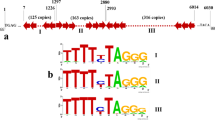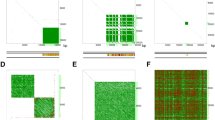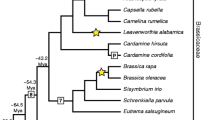Abstract
Chromosome termini of most eukaryotes end in tracks of short tandemly repeated GC-rich sequences, the composition of which varies among different groups of organisms. Plant species predominantly contain (TTTAGGG)n repeats at their telomeres. However, a few plant species, including members of Alliaceae and Aloe spp. (Asphodelaceae) were found to lack such Arabidopsis-type (T3AG3)n telomeric repeats. Recently, it has been proposed that the lack of T3AG3 telomeric repeat sequences extends to all species forming the Asparagales clade. Here, we analysed the composition of Aloe telomeres by single-primer PCR and fluorescence in-situ hybridization (FISH) with directly labelled Arabidopsis-type (TTTAGGG)28–43 DNA probe, and with vertebrate-type (TTAGGG)33–50 DNA and a (C3TA2)3 peptide nucleic acid (PNA) probe. It was found that Nicotiana tabacum contained Arabidopsis-type telomeric repeats, while Aloe telomeres lacked the corresponding FISH signals. Surprisingly, FISH with the highly specific vertebrate-type (C3TA2)3 PNA probe resulted in strong T2AG3-specific FISH signals at the ends of chromosomes of both Aloe and Nicotiana tabacum, suggesting the presence of T2AG3 telomeric repeats in these species. FISH with a long (TTAGGG)33–50 DNA probe also highlighted Aloe chromosome ends, while this probe failed to reveal FISH signals on tobacco chromosomes. These results indicate the presence of vertebrate-like telomeric sequences at the telomeres of Aloe spp. chromosomes. However, single-primer PCR with (T2AG3)5 primers failed to amplify such sequences in Aloe, which could indicate a low copy number of T2AG3 repeats at the chromosome ends and/or their co-orientation and interspersion with other repeat types. Our results suggest that telomeres of plant species, which were thought to lack GC-rich repeats, may in fact contain variant repeat types.
Similar content being viewed by others
References
Adams SP, Leitch IJ, Bennett MD, Leitch AR (2000a) Aloe L.– a second plant family without (TTTAGGG)n telomeres.Chromosoma 109: 201–205.
Adams SP, Leitch IJ, Bennett MD, Chase MW, Leitch AR (2000b) Ribosomal DNA evolution and phylogeny in Aloe (Asphodelaceae). Am J Bot 87: 1578–1583.
Adams SP, Hartman TPV, Lim KY et al. (2001) Loss and recovery of Arabidopsis-type telomere repeat sequences 5´-(TTTAGGG)n-3´ in the evolution of a major radiation of Lowering plants. Proc R Soc Biol Sci 268: 1541–1546.
Allshire RC, Dempster M, Hastie ND (1989) Human telomeres contain at least three types of G-rich repeat distributed non-randomly. Nucleic Acid Res 17: 4611–4627.
Biessmann H, Mason JM (1997) Telomere maintenance without telomerase. Chromosoma 106: 63–69.
Biessmann H, Zurovcova M, Yao JG, Lozovskaya E, Walter MF (2000) A telomeric satellite in Drosophila virilis and its sibling species. Chromosoma 109: 372–380.
Blackburn EH (1991) Structure and function of telomeres. Nature 350: 569–573.
Blackburn EH, Greider CW (eds) (1995) Telomeres. NewYork: Cold Spring Harbor Laboratory Press.
Brandham PE (1976) The frequency of spontaneous structural change. In: Jones K, Brandham PE, eds. Current Chromosome Research. Amsterdam, The Netherlands: Elsevier, pp 77–87.
Broun P, Ganal MW, Tanksley SD (1992) Telomeric arrays display high levels of heritable polymorphism among closely related plant varieties. Proc Natl Acad Sci USA 89: 1354–1357.
Cox AV, Bennett ST, Parkonny AS, Kenton A, Callimassia MA, Bennett MD (1993) Comparison of plant telomere locations using a PCR-generated synthetic probe. Ann Bot 72: 239–247.
Dandjinou AT, Dionne I, Gravel S, Le Bel C, Parenteau J, Wellinger RJ (1999) Cytological and functional aspects of telomere maintenance. Histol Histopathol 14: 517–524.
Fajkus J, Kovarik A, Kralovics R, Bezdek M (1995) Organization of telomeric and subtelomeric chromatin in the higher plant Nicotiana tabacum. Mol Gen Genet 247: 633–638.
Fitzgerald MS, Shakirov EV, Hood EE, McKnight TD, Shippen DE (2001) Different modes of de novo telomere formation by plant telomerases. Plant J 26: 77–87.
Fuchs J, Brandes A, Schubert I (1995) Telomere sequence localization and karyotype evolution in higher plants. Pl Syst Evol 196: 227–241.
Ganal MW, Lapitan NL, Tanksley SD (1991) Macrostructure of the tomato telomeres. Plant Cell 3: 87–94.
Gilson P, McFadden GI (1995) The chlorarachniophyte: a cell with two different nuclei and two different telomeres. Chromosoma 103: 635–641.
Greider CW (1995) Telomerase biochemistry and regulation. In: Blackburn EH, Greider CW, eds. Telomeres. New York: Cold Spring Harbor Laboratory Press, pp 35–68.
Greider CW, Blackburn EH (1985) Identiccation of a specicc telomere terminal transferase activity in Tetrahymena extracts. Cell 43: 405–413.
Henning KA, Moskowitz N, Ashlock MA, Liu PP (1998) Humanizing the yeast telomerase template. Proc Natl Acad Sci USA 95: 5667–5671.
Higashiyama T, Noutoshi Y, Akiba M, Yamada T (1995). Telomere and LINE-like elements at the termini of the Chlorella chromosome I. Nucleic Acids Symp Ser 34: 71–72.
Hiraoka Y, Henderson E, Blackburn EH (1998) Not so peculiar: fission yeast telomere repeats. Trends Biochem Sci 23: 126.
Hultdin M, Grönlund E, Norrback K-F, Eriksson-Lindström E, Just T, Roos G (1998) Telomere analysis by Luorescence in situ hybridization and Low cytometry. Nucleic Acids Res 26: 3651–3656.
Ijdo JW, Wells RA, Baldini A, Reeders ST (1991) Improved telomere detection using a telomere repeat probe (TTAGGG)n generated by PCR. Nucleic Acids Res 19: 4780.
Kamnert I, Lopez CC, Rosen M, Edstrom JE (1997) Telomeres terminating with long complex tandem repeats. Hereditas 127: 175–180.
Lansdorp PM (1996) Close encounters of the PNA kind. Nat Biotechnol. 14: 1653.
Lansdorp PM, Verwoerd NP, van de Rijke FM et al. (1996) Heterogeneity in telomere length of human chromosomes. Hum Mol Genet 5: 685–691.
McEachern MJ, Krauskopf A, Blackburn EH (2000) Telomeres and their control. Annu Rev Genet 34: 331–358.
McKnight TD, Fitzgerald MS, Shippen DE (1997) Plant telomeres and telomerases. A review. Biochemistry (Moscow) 62: 1224–1231.
Meyne J, Ratliff RL, Moyzis RK (1989) Conservation of the human telomere sequence (TTAGGG)n among vertebrates. Proc Natl Acad Sci USA 86: 7049–7053.
Nelson DL, Ledbetter SA, Corbo L et al. (1989) Alu polymerase chain reaction: a method for rapid isolation of human-specicc sequences from complex DNA sources. Proc Natl Acad Sci USA 86: 6686–6690.
Pardue ML, DeBaryshe PG (1999) Drosophila telomeres: two transposable elements with important roles in chromosomes. Genetica 107: 189–196.
Petracek ME, Lefebvre PA, Silflow CD, Berman J (1990) Chlamydomonas telomere sequences are A+T-rich but contain three consecutive G–C base pairs. Proc Natl Acad Sci USA 87: 8222–8226.
Pich U, Schubert I (1998) Terminalhe terochromatin and alternative telomeric sequences in Allium cepa. Chromosome Res 6: 315–321.
Pich U, Fuchs J, Schubert I (1996) How do Alliaceae stabilize their chromosome ends in the absence of TTTAGGG sequences. Chromosome Res 4: 207–213.
Richards EJ, Ausubel FM (1988) Isolation of a higher eukaryotic telomere from Arabidopsis thaliana. Cell 53: 127–136.
Richards EJ, Chao S, Vongs A, Yang J (1992) Characterization of Arabidopsis thaliana telomeres isolated in yeast. Nucleic Acids Res 20: 4039–4046.
Riha K, McKnight TD, Grifcng LR, Shippen DE (2001) Living with genome instability: plant responses to telomere dysfunction. Science 291: 1797–1800.
Scherthan H, Cremer T (1994) Methodology of non-isotopic in situ hybridization in paracn embedded tissue sections. Meth Mol Genet 5: 223–238.
Schwarzacher T, Heslop-Harrison P (2000) Practical In Situ Hybridization. Oxford: BIOS.
Shippen DE, McKnight TD (1998) Telomeres, telomerase and plant development. Trends Plant Sci 3: 126–130.
Slijepcevic P, Bryant PE (1995) Absence of terminal telomeric FISH signals in chromosomes from immortal Chinese hamster cells. Cytogenet Cell Genet 69: 87–89
Tsujimoto H, Usami N, Hasegawa K, Yamada T, Nagaki K, Sasakuma T (1999) De novo synthesis of telomere sequences at the healed breakpoints of wheat deletion chromosomes. Mol Gen Genet 262: 851–856.
Weiss H, Maluszynska J (2000) Chromosomal rearrangement in autotetraploid plants of Arabidopsis thaliana. Hereditas 133: 255–261.
Zakian VA (1996) Structure, function, and replication of Saccharomyces cerevisiae telomeres. Annu Rev Genet 30: 141–172.
Zijlmans JM, Martens UM, Poon SS et al. (1997) Telomeres in the mouse have large inter-chromosomal variations in the number of T2AG3 repeats. Proc Natl Acad Sci USA 94: 7423–7428.
Author information
Authors and Affiliations
Rights and permissions
About this article
Cite this article
Weiss, H., Scherthan, H. Aloe spp. – plants with vertebrate-like telomeric sequences. Chromosome Res 10, 155–164 (2002). https://doi.org/10.1023/A:1014905319557
Issue Date:
DOI: https://doi.org/10.1023/A:1014905319557




